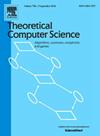Mobile agents on chordal graphs: Maximum independent set and beyond
IF 1
4区 计算机科学
Q3 COMPUTER SCIENCE, THEORY & METHODS
引用次数: 0
Abstract
We consider the problem of finding Maximum Independent Set (MaxIS) for chordal graphs using mobile agents. Suppose n agents are initially placed arbitrarily on the nodes of an n-node chordal graph . Agents need to find a Maximum Independent Set M of G such that each node of M is occupied by at least one agent. Also, each of the n agents must know whether its occupied node is a part of M or not. We provide distributed algorithms for n mobile agents, each having memory, to compute MaxIS of G in time, where m denotes the number of edges in G, n denotes the number of nodes in G, and Δ is the maximum degree of the graph. At first, we design an algorithm considering the case where all agents are initially placed at the same node (i.e., rooted initial configuration). To run this algorithm, the agents do not require prior knowledge of any global parameter. Then we propose an algorithm for the case where agents are initially distributed arbitrarily across the graph (i.e., arbitrary initial configuration). To run this algorithm, the agents require prior knowledge of certain global parameters. Further, we provide faster algorithms for finding MaxIS in chordal graphs either by increasing the memory available to each agent or by employing more agents. We report that by using a similar approach, it is possible to find the maximum clique in chordal graphs and color any chordal graph with the minimum number of colors. We also provide a dynamic programming-based distributed algorithm to find a Maximum Independent Set for trees in time.
弦图上的移动代理:最大独立集及以上
我们考虑了使用移动代理的弦图的最大独立集(MaxIS)问题。假设n个agent最初被任意放置在一个n节点弦图G=(V,E)的节点上。agent需要找到一个最大独立集M (G),使得M的每个节点至少有一个agent占用。另外,n个代理中的每一个都必须知道它所占用的节点是否属于M的一部分。我们为n个移动代理提供分布式算法,每个移动代理具有O(log ln n)内存,以在O(mnlog ln Δ)时间内计算G的MaxIS,其中m表示G中的边数,n表示G中的节点数,Δ是图的最大度。首先,我们设计了一种算法,考虑了所有代理最初被放置在同一节点(即根初始配置)的情况。要运行该算法,代理不需要预先知道任何全局参数。然后,我们提出了一种算法,用于代理最初在图上任意分布(即任意初始配置)的情况。为了运行该算法,代理需要预先知道某些全局参数。此外,我们通过增加每个代理的可用内存或使用更多代理,为在弦图中查找MaxIS提供了更快的算法。我们报告说,通过使用类似的方法,可以找到弦图中的最大团,并用最少的颜色数为任何弦图上色。我们还提供了一个基于动态规划的分布式算法,在O(n)时间内找到树的最大独立集。
本文章由计算机程序翻译,如有差异,请以英文原文为准。
求助全文
约1分钟内获得全文
求助全文
来源期刊

Theoretical Computer Science
工程技术-计算机:理论方法
CiteScore
2.60
自引率
18.20%
发文量
471
审稿时长
12.6 months
期刊介绍:
Theoretical Computer Science is mathematical and abstract in spirit, but it derives its motivation from practical and everyday computation. Its aim is to understand the nature of computation and, as a consequence of this understanding, provide more efficient methodologies. All papers introducing or studying mathematical, logic and formal concepts and methods are welcome, provided that their motivation is clearly drawn from the field of computing.
 求助内容:
求助内容: 应助结果提醒方式:
应助结果提醒方式:


